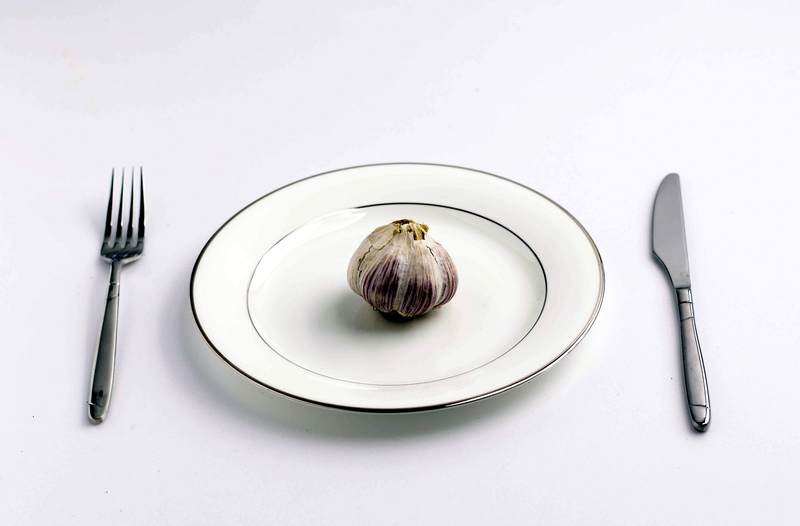Ever wonder why you never hear mention of certain well-known herbs in the higher echelons of herbal medicine? Garlic is one such unsung herb. I once asked my prominent TCM and Ayurvedic herbalist cohorts why garlic is not included in any of the classical texts and higher level discussions of herbal medicine in these respective systems. Both provided a similar response: essentially, garlic is just too common and crude. In this blog, I want to reaffirm my high regard for garlic.
Whole books have been written about its healing properties, but you need go no further than herbalist Christopher Hobbs’ article on garlic. According to Hobbs, Ayurvedic herbal theory considers garlic, called lasuna in Sanskrit, “tonic, hot, digestive, aperient, cholagogue and alterative.” Various simple Ayurvedic practices used to administer garlic are not all that different from some of those used in Europe and the US. One is to crush garlic in honey and take it to relieve coughs, flu, fever, parasites, and other infectious diseases. Strong herbs like garlic often require ingenious vehicles of administration in order to lessen their harshness. In Ayurveda, it is crushed and taken in boiled milk with the addition of honey. In traditional Chinese medicine, garlic is called suan. It is described as having a pungent taste, warm nature and acts on the Spleen, Stomach and Lung. Its spicy property is used to promote the circulation of Qi and Blood, remove masses from the abdomen, eliminate toxic substances, destroy parasites (internally and externally) and treat a wide variety of diseases including: feeling of cold, swollen abdomen, diarrhea, dysentery, malaria, cough, boils and pyogenic infections, tinea capitis, and snake or other venomous bites and stings. I’ve never found it as part of a TCM classical formula, perhaps because it is so strong and the flavor is overwhelming. For medicinal use, the Chinese do recommend crushing it and eating it raw, mashed, decocted, or with food. Western herbalists are great believers in Allium sativum. The use of garlic in the West is well known and especially widely used in countries surrounding the Mediterranean Sea. Garlic is so highly respected that many herbalists quip, “It can be used to cure every disease except the one it causes (bad breath)!” For this I recommend taking some parsley after eating garlic.
The Antibiotic Power of Raw Garlic
Today, garlic is appreciated as an herb to help the cardiovascular system and lower blood pressure. But Hobbs and I both agree that garlic is probably the single most potent antibiotic herb there is. Perhaps the most important chemical constituent found in garlic is the organosulfur compound allicin. When fresh garlic is chopped or crushed, the enzyme alliinase converts alliin into allicin. This is responsible for the strong aroma of fresh garlic, which travels throughout the body very quickly from direct contact through the blood stream. (If you want to prove this, try rolling and crushing a clove of fresh garlic with the sole of your foot and count the seconds before the smell is emitted through the breath of your mouth. This is what makes garlic so particularly effective for the lungs and bronchioles.) Further enzymatic changes of allicin quickly occur producing other sulfur compounds such as diallyl disulfide. These are all known to have antibacterial, antiviral, antifungal, antiprotozoal and antiyeast activity making garlic both a powerful treatment as well as preventive of infectious diseases. At the first sign of an upper respiratory infection of any kind, I recommend taking garlic in my favorite preparation: mash several raw cloves into some olive oil and take a hefty dose (about a teaspoonful) hourly when needed by dipping a bit of bread into the olive oil and garlic mix. This can help cure the disease but for certain, it prevents its progression. Aged and fermented garlic is widely promoted in the market. This is a Japanese method to enable one to benefit from the positive effects of garlic especially for the immune and cardiovascular system without the strong smell. Cooking or fermenting garlic largely destroys the antibacterial sulfuric compounds mentioned above, but again the many other health benefits of garlic especially for digestion, cardiovascular and immune system will still be present. However, if you are looking to use garlic for its more acute antibacterial and antiviral properties and benefits for the lungs and respiratory system you need the odor which carries these properties to those parts of the body.
A Delicious Way to Prevent Cold or Flu
I’d like to share a very special, delicious garlic food remedy given to me by one of my students and neighbor, Kathryn Grant. It is her ‘go-to’ first line treatment for acute colds or flu and I can attest that it really works. Garlic Fettuccine 3 ounces fettuccine, cooked al dente 1 whole garlic bulb, sliced 2 tablespoons olive oil 2 to 3 tablespoons half and half 2 to 3 tablespoons Parmesan cheese Cayenne pepper Gently heat olive oil over a low/medium flame. Add garlic and sauté until fragrant (30 seconds). Add fettuccine, half and half, and toss. Sprinkle with Parmesan and a little cayenne (next month’s crude, rude herb!), and toss until creamy and pasta is coated.

